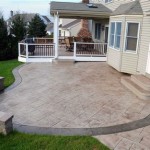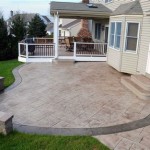Can You Seal A Concrete Patio? A Comprehensive Guide
Concrete patios offer a durable and versatile outdoor living space. However, concrete is porous, making it susceptible to damage from water, stains, and freeze-thaw cycles. Sealing a concrete patio provides a protective barrier, extending its lifespan and enhancing its appearance. This article will explore the benefits of sealing, the types of sealers available, the preparation process, application techniques, and maintenance considerations for a sealed concrete patio.
Why Seal a Concrete Patio? The Benefits Explained
Sealing a concrete patio is a proactive measure that offers numerous advantages. Unsealed concrete is highly absorbent, readily soaking up liquids like water, oil, and spills. This absorption leads to staining, cracking, and the growth of mold and mildew. Sealing acts as a shield, preventing these issues and preserving the integrity of the concrete. Here are some key benefits:
Protection Against Water Damage: One of the primary reasons to seal a concrete patio is to protect it from water damage. Water penetration can lead to cracks, spalling (surface flaking), and the expansion and contraction of the concrete, particularly in climates with freezing temperatures. When water freezes within the pores of the concrete, it expands, exerting pressure that can cause the surface to break down. A sealant creates a waterproof barrier, minimizing water absorption and preventing freeze-thaw damage.
Stain Resistance: Concrete readily absorbs spills, leading to unsightly stains from oil, grease, wine, and other common patio contaminants. Once a stain penetrates the concrete, it can be difficult, if not impossible, to remove completely. Sealants create a barrier that prevents liquids from soaking into the concrete, making spills easier to clean up and preventing permanent staining.
Increased Durability and Lifespan: By protecting against water damage and staining, sealants significantly extend the lifespan of a concrete patio. Sealed concrete is less prone to cracking, spalling, and other forms of deterioration, reducing the need for costly repairs and replacements.
Enhanced Appearance: Sealants can enhance the appearance of a concrete patio, giving it a more polished and attractive look. Some sealants are available in a variety of finishes, from matte to glossy, allowing homeowners to customize the appearance of their patio. Others can be tinted or stained to further enhance the color and texture of the concrete.
Easier Maintenance: Sealed concrete is easier to clean than unsealed concrete. The smooth, non-porous surface created by a sealant allows for easy removal of dirt, debris, and spills with a simple sweep or hose down. This reduces the amount of time and effort required to maintain the patio's appearance.
Types of Concrete Sealers: Choosing the Right Option
Selecting the appropriate sealant is crucial for achieving the desired level of protection and appearance. There are several types of concrete sealers available, each with its own unique properties and benefits. The most common types include:
Acrylic Sealers: Acrylic sealers are a popular choice for concrete patios due to their affordability, ease of application, and wide availability. They provide a durable, water-resistant finish that protects against staining and wear. Acrylic sealers are available in both water-based and solvent-based formulas. Water-based acrylic sealers are generally considered more environmentally friendly and easier to clean up, while solvent-based acrylic sealers offer better penetration and durability.
Penetrating Sealers (Silanes and Siloxanes): Penetrating sealers, such as silanes and siloxanes, work by penetrating the surface of the concrete and chemically reacting with the cement to create a hydrophobic (water-repellent) barrier. These sealers do not form a surface film, so they do not alter the appearance of the concrete or make it slippery. Penetrating sealers are particularly effective at preventing water damage and are often used in areas with harsh weather conditions.
Epoxy Sealers: Epoxy sealers provide a very durable and chemical-resistant finish. They are often used in high-traffic areas or where resistance to chemicals and abrasion is required. Epoxy sealers are typically two-part systems that require mixing before application. They provide a glossy, hard finish that is resistant to staining and wear.
Polyurethane Sealers: Polyurethane sealers are known for their flexibility and abrasion resistance. They provide a durable, long-lasting finish that is resistant to cracking and peeling. Polyurethane sealers are often used in areas with heavy foot traffic or where flexibility is required to accommodate movement in the concrete. They are available in both water-based and solvent-based formulas.
Choosing the Right Sealer: The best type of sealant for a concrete patio depends on several factors, including the climate, the level of traffic, the desired appearance, and the budget. For example, in areas with harsh winters, a penetrating sealer may be the best choice for preventing freeze-thaw damage. In high-traffic areas, an epoxy or polyurethane sealer may be more suitable due to its durability and abrasion resistance. Ultimately, consulting with a concrete specialist or reading product reviews can assist in selecting the optimal sealant for a specific patio project.
The Sealing Process: Preparation, Application, and Maintenance
Successfully sealing a concrete patio involves thorough preparation, proper application techniques, and ongoing maintenance. Failing to follow these steps can compromise the effectiveness of the sealant and shorten its lifespan.
Preparation: The most crucial step in sealing a concrete patio is proper preparation. The concrete surface must be clean, dry, and free of any dirt, debris, oil, grease, or existing coatings. Any cracks or imperfections should be repaired before sealing. The preparatory steps include:
Cleaning: Thoroughly clean the concrete patio using a pressure washer and a concrete cleaner or degreaser. Remove any loose dirt, debris, and stains. For stubborn stains, use a specialized concrete stain remover. Allow the concrete to dry completely before proceeding.
Repairing Cracks and Imperfections: Inspect the concrete patio for any cracks or imperfections. Fill any cracks with a concrete crack filler or patching compound. Follow the manufacturer's instructions for application and curing. Allow the patching compound to dry completely before proceeding.
Etching (Optional): Etching the concrete surface can improve the adhesion of the sealant. This involves applying a mild acid solution to the concrete, which opens up the pores and creates a rougher surface. Follow the manufacturer's instructions for etching and neutralize the acid solution before proceeding.
Application: The application process varies depending on the type of sealant being used. However, some general guidelines apply:
Follow Manufacturer's Instructions: Always follow the manufacturer's instructions for application. This includes recommended application rates, drying times, and safety precautions.
Apply Evenly: Apply the sealant evenly using a roller, brush, or sprayer. Avoid applying too much sealant in one area, as this can lead to drips and runs.
Apply Multiple Coats: Applying multiple thin coats of sealant is generally better than applying one thick coat. This ensures that the sealant penetrates the concrete properly and provides a more durable finish.
Allow Adequate Drying Time: Allow the sealant to dry completely before walking on the patio or placing furniture on it. The drying time will vary depending on the type of sealant and the weather conditions.
Maintenance: Once the concrete patio has been sealed, it is important to maintain it properly to ensure its longevity. Regular maintenance includes:
Cleaning: Clean the patio regularly to remove dirt, debris, and spills. Use a mild soap and water solution and a soft brush or mop. Avoid using harsh chemicals or abrasive cleaners, as these can damage the sealant.
Re-Sealing: Over time, the sealant will wear down and lose its effectiveness. Re-seal the patio every few years to maintain its protection and appearance. The frequency of re-sealing will depend on the type of sealant used and the level of traffic on the patio.
Inspecting for Damage: Regularly inspect the patio for any cracks, chips, or other damage. Repair any damage promptly to prevent further deterioration. By following these steps, a sealed concrete patio can provide years of enjoyment and enhance the value of a home.

Why You Should Seal Your Concrete Driveway Or Patio Gleam Team

Pros And Cons Of Sealing Concrete Patios

Professional Concrete Sealing Types Methods In Wichita

How To Seal Concrete The Right Way Project Summary Bob Vila

Sealing A Concrete Patio What S The Best Sealer Network

Beautify And Protect Your Patio

Concrete Stain And Sealer Patio Makeover Exchange

How To Seal Concrete For A Uniform Appearance Decor

Choosing The Right Concrete Sealer For Job Decor

Concrete Stamped Patio Sealing
Related Posts








